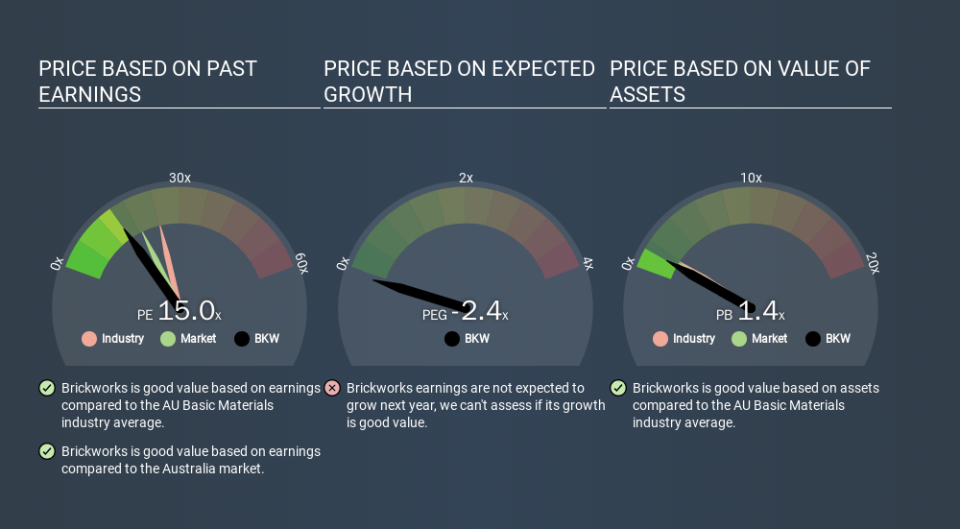Here's How P/E Ratios Can Help Us Understand Brickworks Limited (ASX:BKW)

Today, we'll introduce the concept of the P/E ratio for those who are learning about investing. We'll look at Brickworks Limited's (ASX:BKW) P/E ratio and reflect on what it tells us about the company's share price. What is Brickworks's P/E ratio? Well, based on the last twelve months it is 14.99. In other words, at today's prices, investors are paying A$14.99 for every A$1 in prior year profit.
View our latest analysis for Brickworks
How Do I Calculate A Price To Earnings Ratio?
The formula for price to earnings is:
Price to Earnings Ratio = Share Price ÷ Earnings per Share (EPS)
Or for Brickworks:
P/E of 14.99 = AUD19.72 ÷ AUD1.32 (Based on the trailing twelve months to July 2019.)
Is A High Price-to-Earnings Ratio Good?
A higher P/E ratio means that buyers have to pay a higher price for each AUD1 the company has earned over the last year. That isn't necessarily good or bad, but a high P/E implies relatively high expectations of what a company can achieve in the future.
Does Brickworks Have A Relatively High Or Low P/E For Its Industry?
The P/E ratio essentially measures market expectations of a company. We can see in the image below that the average P/E (24.3) for companies in the basic materials industry is higher than Brickworks's P/E.
Its relatively low P/E ratio indicates that Brickworks shareholders think it will struggle to do as well as other companies in its industry classification. While current expectations are low, the stock could be undervalued if the situation is better than the market assumes. You should delve deeper. I like to check if company insiders have been buying or selling.
How Growth Rates Impact P/E Ratios
P/E ratios primarily reflect market expectations around earnings growth rates. When earnings grow, the 'E' increases, over time. That means even if the current P/E is high, it will reduce over time if the share price stays flat. And as that P/E ratio drops, the company will look cheap, unless its share price increases.
Brickworks's earnings per share grew by -9.9% in the last twelve months. And its annual EPS growth rate over 5 years is 14%.
Remember: P/E Ratios Don't Consider The Balance Sheet
The 'Price' in P/E reflects the market capitalization of the company. So it won't reflect the advantage of cash, or disadvantage of debt. In theory, a company can lower its future P/E ratio by using cash or debt to invest in growth.
Such spending might be good or bad, overall, but the key point here is that you need to look at debt to understand the P/E ratio in context.
How Does Brickworks's Debt Impact Its P/E Ratio?
Brickworks has net debt worth just 8.7% of its market capitalization. The market might award it a higher P/E ratio if it had net cash, but its unlikely this low level of net borrowing is having a big impact on the P/E multiple.
The Verdict On Brickworks's P/E Ratio
Brickworks has a P/E of 15.0. That's below the average in the AU market, which is 18.9. The company hasn't stretched its balance sheet, and earnings are improving. If growth is sustainable over the long term, then the current P/E ratio may be a sign of good value.
Investors should be looking to buy stocks that the market is wrong about. As value investor Benjamin Graham famously said, 'In the short run, the market is a voting machine but in the long run, it is a weighing machine. So this free visual report on analyst forecasts could hold the key to an excellent investment decision.
But note: Brickworks may not be the best stock to buy. So take a peek at this free list of interesting companies with strong recent earnings growth (and a P/E ratio below 20).
If you spot an error that warrants correction, please contact the editor at editorial-team@simplywallst.com. This article by Simply Wall St is general in nature. It does not constitute a recommendation to buy or sell any stock, and does not take account of your objectives, or your financial situation. Simply Wall St has no position in the stocks mentioned.
We aim to bring you long-term focused research analysis driven by fundamental data. Note that our analysis may not factor in the latest price-sensitive company announcements or qualitative material. Thank you for reading.

 Yahoo News
Yahoo News 
